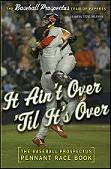Read this interesting article on MLB.com titled "Westworld: 'Moneyball' vs. Mikeyball". In the article, the author Doug Miller, contrasts the approach of the Angels and Mike Scioscia and the A's and Billy Beane. In talking about the Angels Miller notes:
"They're also not going to apologize for their brand of offense, which is built around aggressive baserunning, calculated situational hitting and constant pressure on defenses."
To highlight this he notes that the Angels were 28th in the majors and last in the AL in walks in 2004 with 450. As for the A's he says:
"The Oakland A's, of course, have been molded into an on-base-percentage machine. General manager Billy Beane's strategy is to draw walk after walk, tire out pitchers, then slug away and drive in runs."
And together:
"Both organizations believe strongly in their philosophies and both have good points. One preaches patience, the other pressure."
The A's as expected were fifth in walks with 608. Call me a skeptic but I tend to think that 158 more baserunners is a better bet to produce runs than "aggressive baserunning" and "calculated situational hitting". Of course, in the final analysis the Angels scored 836 runs while the A's scored 793 even though the A's hit 189 homeruns and Angels just 162. How did they do it?
Interestingly, the Angels seemed to squeeze more runs from their offensive elements as compared to various run estimators.
R OPS RC BR BsR
A's 793 .778 837 840 835
Angels 836 .772 830 807 797
As you can see, had they both scored the amount predicted by their offensive elements the A's would have outscored the Angels, although not by much despite the A's advantages in walks and homeruns. This is the case since their OPS was almost equivalent due to the fact that Oakland hit .270 as a team while the Angels hit .282 which resulted in almost identical on base and slugging percentages.
What is interesting is that the Angels scored 20 or so more runs than would be expected while the A's scored about 40 fewer runs. Could this be accounted for by baserunning? In the article the author quotes Scioscia:
"'We all agree with on-base percentage, but 'Moneyball' doesn't tell the whole story, I put much more stock in getting into scoring position than on-base percentage. If you have team speed, you have to use it.'
By Scioscia's numbers, the Angels ranked second in the Majors last year with 99 successful advances from first base to third on base hits. The Angels were thrown out six times trying that move. Scioscia says the A's only tried it 36 times and were thrown out twice."
Well, according to my baserunning framwork the Angels had 375 opportunities to advance on a single when a runner was on first. In those chances the runner on first advanced to third 107 times, scored 4 times, and was thrown out 10 times. The A's on the other hand 340 chances, advancing to third 81 times, scoring twice and getting thrown out four times. So even with their aggressive style the Angels netted only 20 more bases in these situations. And if you consider that the six extra runners taken off the bases are relatively much more expensive, it would seem that the teams are fairly close. I'm not sure why the numbers in the article are different than what I found but I also ran the numbers when second base was not occupied and got the following:
Opp To3 Score Out
ANA 271 74 3 7
OAK 235 58 2 1
In this scenario the difference shrinks to 10 extra bases for the Angels.
When looked at as a whole the Angels and A's baseunning were pretty similar with the Angels gaining about 6 bases less than would be expected while the A's gained about 13 less. Neither of these results helps to explain the +20 run difference for the Angels and the -40 run difference for the A's.
So what could it be?
It's that "calculated situational hitting"! This is borne out by the difference in the teams hitting with runners in scoring position. The Angels hit .278/.343/.440 and scored 659 runs (3rd in the league) when batting with runners in scoring position while the A's hit just .260/.352/.410 and scored just 573 runs (17th in the league). And with runners on the Angels hit .291/.351/.456 while the A's managed .268/.350/.430. You probably could have guessed this by noting that the Angels had 35 more singles with a runner on first than the A's did despite the fact that they netted 73 more baserunners (H+BB-HR) on the season than the Angels did.
The real question is whether the Angels hot hitting is simply luck or a real skill. Sabermetric analysis has typically poo pooed such notions as pointed out in my post on Bill James' article in the Baseball Research Journal. I ran a few regressions on hitting with runners on in 2003 and 2004 at the team level and found the following correlation coefficients:
BA: .320
OBP: .352
SLG: .366
OPS: .328
Not a strong correlation but not totally random either. It'll be interesting to see how the Angels do with their strategy this year.
125x125_10off+copy.jpg)



No comments:
Post a Comment